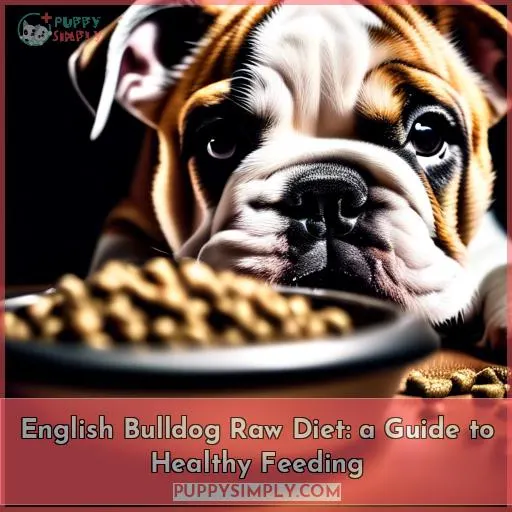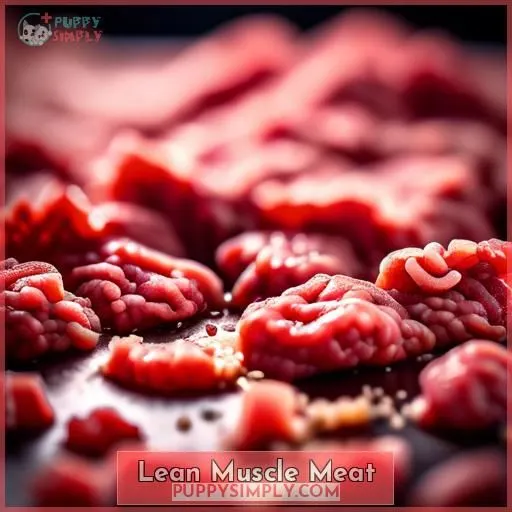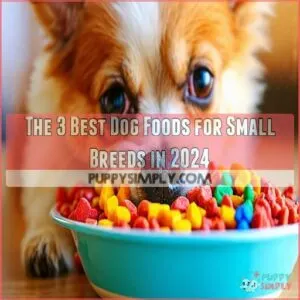This site is supported by our readers. We may earn a commission, at no cost to you, if you purchase through links.

Switching your English Bulldog to a raw food diet can offer them a feast of benefits custom-made to their unique nutritional needs. A raw diet provides complete control over ingredients, guarantees a balanced and species-appropriate diet, and reduces the risk of digestive issues and food sensitivities.
The components of a good raw diet include whole organs, fish, fruits and vegetables, lean muscle meat, and bones. Lean muscle meat is an indispensable element for a balanced diet, providing protein and amino acid makeup for muscular growth. Bones play a critical role in a raw diet, serving as a natural source of calcium and phosphorus.
Easy raw dog food recipes, such as fish dinner, organ patties, satin balls, and basic mix, can be prepared using fish fillets, canned meat, liver, eggs, vegetables, kelp powder, honey, organs, vegetables, eggs, ground beef, oats, oil, molasses, gelatin, chicken necks, hearts, livers, and salmon.
Table Of Contents
- Key Takeaways
- Raw Food Basics
- The Components of a Good Raw Diet
- Lean Muscle Meat
- Bones
- Easy Raw Dog Food Recipes
- Frequently Asked Questions (FAQs)
- What are the benefits of feeding a raw food diet to a Bulldog?
- How can I ensure my Bulldog receives a balanced diet on a raw food diet?
- What precautions should I take when feeding my Bulldog a raw food diet to avoid contamination?
- How can I supplement my Bulldog’s raw food diet to ensure proper nutrient intake?
- How can I transition my Bulldog from a kibble diet to a raw food diet?
- Conclusion
Key Takeaways
- A raw food diet for English Bulldogs can provide numerous health benefits, including complete control over ingredients, a balanced and species-appropriate diet, reduced risk of digestive issues and food sensitivities, and beneficial probiotics for gut health.
- Key components of a good raw diet include whole organs, fish, fruits and vegetables, lean muscle meat, and bones. Lean muscle meat provides protein and amino acids for muscular growth, while bones serve as a natural source of calcium and phosphorus.
- Easy raw dog food recipes can be prepared using fish fillets, canned meat, liver, eggs, vegetables, kelp powder, honey, organs, vegetables, eggs, ground beef, oats, oil, molasses, gelatin, chicken necks, hearts, livers, and salmon.
- When transitioning a dog to a raw food diet, it’s recommended to do so gradually, starting with a combination of old and new food and gradually increasing the proportion of raw food over time.
Raw Food Basics
A raw food diet can provide numerous advantages for your dog’s health. It gives complete control over the ingredients, guaranteeing you can prevent unidentified meats or chemicals that may not be beneficial for your dog. The high nutritional value of raw food implies that your dog can attain a balanced and species-adequate diet, which can result in enhanced digestion and better nutrient absorption. Additionally, raw food diets usually contain fewer allergens and irritants than processed foods, reducing the risk of digestive issues and food sensitivities.
Raw food diets can also provide beneficial probiotics, which assist in digestion and support a balanced gut microbiome. Moreover, raw food can lead to firmer stools, indicating improved digestion and nutrient absorption. By mimicking the natural diet of dogs’ wild ancestors, raw food diets can promote healthy digestion, reduce the risk of digestive issues, and provide a host of benefits for your dog’s gut health.
In terms of the raw food diet itself, it typically consists of 5 parts meat with bone, 1 part organ meat, 1 part cooked vegetables, lean meats (less than 10% fat), bones (15% of diet), organs (10% of diet), fish (omega fatty acids), and fruits and vegetables (fiber, antioxidants). Easy raw dog food recipes include a basic mix of meat, organs, vegetables, and eggs; organ patties made from organs, vegetables, and eggs; satin balls made from ground beef, oats, eggs, oil, molasses, and gelatin; fish dinner with fish fillets, canned meat, liver, eggs, vegetables, kelp powder, and honey; and chicken dinner with chicken necks, hearts, livers, salmon, and vegetables.
When introducing your dog to a raw food diet, it’s recommended to do so gradually. Start by combining 75% of the old food with 25% of the new raw food for the first three days, then gradually decrease the proportion of old food and increase the proportion of raw food over the next seven days.
The Components of a Good Raw Diet
A wholesome raw diet for your English Bulldog should encompass a diverse array of components to guarantee balanced nourishment. Here are three crucial considerations:
- Whole Organs: These are replete with vitamins and minerals that bolster your dog’s well-being. Organs such as liver, kidney, and heart can be integrated into your dog’s meals.
- Fish: Fish supplies essential omega fatty acids that foster healthy skin and coat, and they’re also a prime source of protein. Salmon, sardines, and mackerel are favored options among dog food producers.
- Fruits and Vegetables: These inject fiber, antioxidants, and other beneficial nutrients into your dog’s diet. Apples, carrots, and green beans are some examples of fruits and vegetables that can be included in your English Bulldog’s raw dog food regimen.
Lean Muscle Meat
As we explore the realm of raw feeding, let’s focus on the protein sources that constitute the bedrock of a balanced diet for your English Bulldog. Lean muscle meat is an indispensable element, providing the requisite protein and amino acid makeup for muscular growth.
When selecting protein sources, consider their fat content. Lean meats, like chicken, turkey, and beef, are optimal. They strike the ideal equilibrium of protein and fat, guaranteeing your pet receives the essential nutrients without surplus calories.
Integrating lean meats into your dog’s diet not merely fosters muscle development but also contributes to their overall well-being. By comprehending the significance of protein sources in pet care, you can make informed choices about your English Bulldog’s diet, ensuring they receive the finest nutrition possible.
Let’s now delve into the significance of bones in a raw diet.
Bones
Bones play a critical role in your English Bulldog’s raw diet. They’re a natural source of calcium and phosphorus, essential minerals for strong bones and teeth. Bones also provide your dog with bone marrow, a rich source of vitamins and minerals.
However, not all bones are created equal. Raw bones, especially those from poultry, can splinter and pose a choking hazard. Stick to beef, lamb, and fish bones, which are safer for your pet.
Bone supplements and bone substitutes can also be key, especially for older dogs or those with joint issues. Always consult with your veterinarian before incorporating any new dietary elements into your pet’s meals.
A balanced raw diet is paramount for your Bulldog’s health and well-being, so be sure to include a variety of proteins, vegetables, and fruits.
Easy Raw Dog Food Recipes
Switching your dog to a raw diet can be an exciting journey, and with these easy raw dog food recipes, you’ll be able to provide your furry friend with a balanced and nutritious meal. Here are some recipes to get you started:
- Fish Dinner: Combine fish fillets, canned meat, liver, eggs, vegetables, kelp powder, and honey to create a delicious and balanced meal for your dog.
- Organ Patties: Mix organs, vegetables, and eggs to create these tasty patties that are packed with essential nutrients.
- Satin Balls: Use ground beef, oats, eggs, oil, molasses, and gelatin to make these high-calorie and high-fat treats for dogs.
- Basic Mix: Include meat, organs, vegetables, and eggs in this simple recipe to provide a balanced and nutritious meal for your dog.
- Chicken Dinner: Cook chicken necks, hearts, livers, salmon, and vegetables to create a meal that’s both tasty and healthy for your dog.
Remember to consult with a veterinarian or nutritionist before starting your dog on a raw diet to make sure they’re getting the right vitamins and minerals. Always store raw food properly and follow proper hygiene when handling and serving it to your dog. With these easy recipes, you’ll be able to provide your dog with a healthy and balanced diet that they’ll love.
Frequently Asked Questions (FAQs)
What are the benefits of feeding a raw food diet to a Bulldog?
Feeding a raw food diet to a Bulldog can offer numerous benefits. These include improved digestion, better dental health, and potential resolution of digestive issues and allergy symptoms. Bulldogs have a digestive tract similar to wolves, making them best suited for high-protein diets that include meat, bones, and offal.
A raw diet can also provide complete control over ingredients, ensuring that the dog isn’t consuming mystery meats or chemicals often found in kibble.
How can I ensure my Bulldog receives a balanced diet on a raw food diet?
Balancing Bulldog meals means mixing meaty muscles, crunchy cartilage, and vibrant veggies. Consult a vet, follow the 5:1:1 formula, and vary the menu to make sure your furry friend’s diet is nutritionally complete.
What precautions should I take when feeding my Bulldog a raw food diet to avoid contamination?
To guarantee your Bulldog receives a balanced diet on a raw food diet, follow these guidelines:
- Include lean muscle meat, bones, whole organs, fish, fruits, and vegetables in the diet.
- Maintain a 5:1:1 ratio of meat with bone, organ meat, and cooked vegetables.
- Choose lean meats with less than 10% fat.
- Incorporate bones (15% of diet) and organs (10% of diet).
- Include fish for omega fatty acids.
- Provide fiber from fruits, vegetables, and berries.
To avoid contamination when feeding your Bulldog a raw food diet, follow these precautions:
- Separate raw pet food from human food.
- Wash produce but don’t wash raw meat.
- Refrigerate raw pet food to avoid spoilage.
- Freeze raw pet food for long-term storage and don’t thaw it in hot or warm water or the microwave.
- Clean and sanitize prep space, tools, and the area where the pet eats.
- Wash hands after contact with raw pet food, containers, and pet waste.
- Pick up and store uneaten food in the refrigerator to feed at the next meal.
- Disinfect surfaces, utensils, and objects that raw food has touched with hot, soapy water or a dishwasher on the sanitize setting.
How can I supplement my Bulldog’s raw food diet to ensure proper nutrient intake?
To guarantee adequate nutrient intake for your Bulldog on a raw food diet, contemplate the following supplements:
- Glucosamine: This supplement can assist in promoting joint health, which is imperative for Bulldogs susceptible to joint problems.
- Omega-3 Fatty Acids: These indispensable fatty acids can ameliorate skin and coat health, as well as mitigate inflammation.
- Probiotics: Probiotics can facilitate digestion and support a salubrious gut microbiome, which can be advantageous for Bulldogs with digestive ailments.
- Multivitamin: A multivitamin can assist in verifying your Bulldog receives all the requisite vitamins and minerals, particularly if you’re providing a homemade raw diet.
How can I transition my Bulldog from a kibble diet to a raw food diet?
Beginning a gustatory expedition, gradually blend uncooked delicacies with their existing diet over 10 days, incrementally elevating the uncooked proportion. This delicate alteration guarantees a seamless transformation, maintaining tails in motion and stomachs contented.
Conclusion
Switching your English Bulldog to a raw food diet can offer them a feast of benefits custom-made to their unique nutritional needs. A raw diet provides complete control over ingredients, guarantees a balanced and species-appropriate diet, and reduces the risk of digestive issues and food sensitivities.
The components of a good raw diet include whole organs, fish, fruits and vegetables, lean muscle meat, and bones. Lean muscle meat is an indispensable element for a balanced diet, providing protein and amino acid makeup for muscular growth. Bones play a critical role in a raw diet, serving as a natural source of calcium and phosphorus.
Easy raw dog food recipes, such as fish dinner, organ patties, satin balls, and basic mix, can be prepared using fish fillets, canned meat, liver, eggs, vegetables, kelp powder, honey, organs, vegetables, eggs, ground beef, oats, oil, molasses, gelatin, chicken necks, hearts, livers, and salmon.











